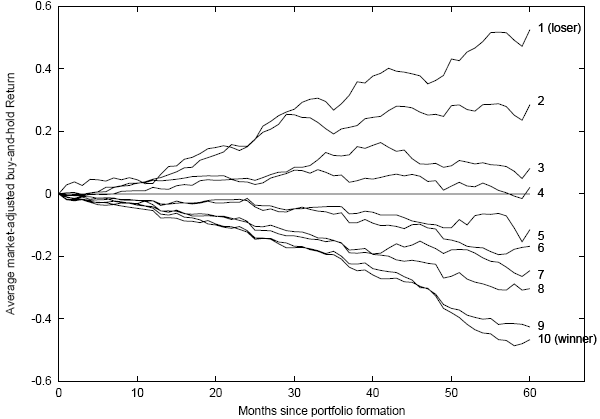Are multi-year runs of bad (good) performance by individual stocks indicative of future returns? In other words, does the long-run behavior of stocks on average persist, reverse or fade to random? In their October 2006 paper entitled “Return Reversal in UK Shares”, Glen Arnold and Rose Baker examine the magnitude, persistence and source of reversals for UK stock returns. Using monthly total return and associated fundamentals data for stocks listed on the London Stock Exchange over the prior five calendar years during 1975-2002 (48 years), they find that:
- Stocks that are the biggest losers over the past five years (39 five-year ranking periods) generally outperform both the past winners and the overall market over the next five years. Specifically, equally-weighted portfolios of the 10% biggest losers (winners) over the past five years outperform (underperform) the equally-weighted market by an average of 53% (47%) over the next five years.
- The more extreme the return during the past five years, the greater the reversal the next five years. (See the first chart below.)
- Extreme past losers outperform extreme past winners by an average of about 14% per year over the next five years. Past loser (winner) portfolios underperform the market approximately one quarter (three quarters) of the time. (See the second chart below.)
- Past losers represent arguably lower risk than past winners based on seven tests (probability of liquidation, reliability, performance in different market/economic states, beta, standard deviation and Fama-French three factors).
- While there is a strong size effect in the sample, return reversal is a feature of large and small companies. Reversal is present for the largest 20% of firms, but is stronger for smaller companies.
The following figure, taken from the paper, shows month-by-month cumulative market-adjusted returns for each decile portfolio over the 60 months after formation. Stocks are are ranked and assigned to deciles annually on the basis of their returns over five calendar years ending in 1959-1997 (39 periods). Portfolios and the market index are equally weighted. The most extreme past losers (portfolio 1) become the strongest subsequent performers. Portfolio 2 takes second place, followed by portfolio 3, and so on systematically down to the extreme past winner portfolio at the bottom.

The next figure, also from the paper, shows market-adjusted five-year buy-and-hold returns for each of 39 annually-formed loser-minus-winner (all companies) hedge portfolios by year of formation. Portfolios and the market index are equally weighted. Arrows indicate years of negative real UK GDP growth. Squares indicate years of negative real return on UK equities overall. Only three of 39 years show negative returns. However, value weighting (not shown) results in several years in the late 1970s to early 1980s when past winners substantially outperform past losers.

In summary, the persistent and robust multi-year reversal of returns observed among UK stocks supports the view that investors overreact to price trends of the past few years, driving good (poor) performers too high (low).
The time intervals used in this research are generally longer than those used in the study of momentum investing, with momentum an effect of months-to-a-year and reversal a multi-year phenomenon.